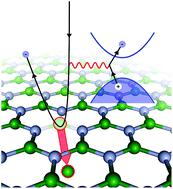Our official English website, www.x-mol.net, welcomes your
feedback! (Note: you will need to create a separate account there.)
Quantum theory of electronic excitation and sputtering by transmission electron microscopy
Nanoscale ( IF 5.8 ) Pub Date : 2022-06-03 , DOI: 10.1039/d2nr01018f Anthony Yoshimura 1, 2 , Michael Lamparski 2 , Joel Giedt 2 , David Lingerfelt 3 , Jacek Jakowski 4 , Panchapakesan Ganesh 3 , Tao Yu 5 , Bobby G Sumpter 3 , Vincent Meunier 2, 6
Nanoscale ( IF 5.8 ) Pub Date : 2022-06-03 , DOI: 10.1039/d2nr01018f Anthony Yoshimura 1, 2 , Michael Lamparski 2 , Joel Giedt 2 , David Lingerfelt 3 , Jacek Jakowski 4 , Panchapakesan Ganesh 3 , Tao Yu 5 , Bobby G Sumpter 3 , Vincent Meunier 2, 6
Affiliation

|
Many computational models have been developed to predict the rates of atomic displacements in two-dimensional (2D) materials under electron beam irradiation. However, these models often drastically underestimate the displacement rates in 2D insulators, in which beam-induced electronic excitations can reduce the binding energies of the irradiated atoms. This bond softening leads to a qualitative disagreement between theory and experiment, in that substantial sputtering is experimentally observed at beam energies deemed far too small to drive atomic dislocation by many current models. To address these theoretical shortcomings, this paper develops a first-principles method to calculate the probability of beam-induced electronic excitations by coupling quantum electrodynamics (QED) scattering amplitudes to density functional theory (DFT) single-particle orbitals. The presented theory then explicitly considers the effect of these electronic excitations on the sputtering cross section. Applying this method to 2D hexagonal BN and MoS2 significantly increases their calculated sputtering cross sections and correctly yields appreciable sputtering rates at beam energies previously predicted to leave the crystals intact. The proposed QED-DFT approach can be easily extended to describe a rich variety of beam-driven phenomena in any crystalline material.
中文翻译:

透射电子显微镜的电子激发和溅射的量子理论
已经开发了许多计算模型来预测电子束照射下二维 (2D) 材料中的原子位移速率。然而,这些模型通常会大大低估二维绝缘体中的位移率,其中束感应电子激发会降低受辐射原子的结合能。这种键软化导致了理论和实验之间的定性分歧,因为在许多当前模型中,在被认为太小而无法驱动原子位错的光束能量下,实验观察到了大量溅射。为了解决这些理论缺陷,本文开发了一种第一性原理方法,通过将量子电动力学 (QED) 散射振幅与密度泛函理论 (DFT) 单粒子轨道耦合来计算束诱导电子激发的概率。然后,所提出的理论明确考虑了这些电子激发对溅射截面的影响。将该方法应用于二维六方 BN 和 MoS22显着增加了他们计算出的溅射截面,并在先前预测会使晶体保持完好无损的光束能量下正确地产生了可观的溅射率。所提出的 QED-DFT 方法可以很容易地扩展到描述任何晶体材料中丰富多样的光束驱动现象。
更新日期:2022-06-03
中文翻译:

透射电子显微镜的电子激发和溅射的量子理论
已经开发了许多计算模型来预测电子束照射下二维 (2D) 材料中的原子位移速率。然而,这些模型通常会大大低估二维绝缘体中的位移率,其中束感应电子激发会降低受辐射原子的结合能。这种键软化导致了理论和实验之间的定性分歧,因为在许多当前模型中,在被认为太小而无法驱动原子位错的光束能量下,实验观察到了大量溅射。为了解决这些理论缺陷,本文开发了一种第一性原理方法,通过将量子电动力学 (QED) 散射振幅与密度泛函理论 (DFT) 单粒子轨道耦合来计算束诱导电子激发的概率。然后,所提出的理论明确考虑了这些电子激发对溅射截面的影响。将该方法应用于二维六方 BN 和 MoS22显着增加了他们计算出的溅射截面,并在先前预测会使晶体保持完好无损的光束能量下正确地产生了可观的溅射率。所提出的 QED-DFT 方法可以很容易地扩展到描述任何晶体材料中丰富多样的光束驱动现象。











































 京公网安备 11010802027423号
京公网安备 11010802027423号